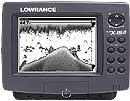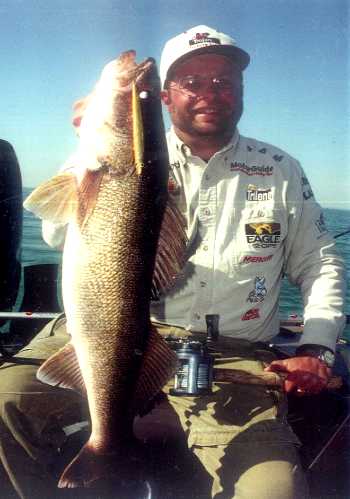
Church Tackles Mr. Walleye
Planer Board

Click
here for more info or to order on-line













Promotional
Team Favorites
Lodging food and more





 Mark Martins
Mark Martins
Lake
Superior Beachfront home for rent



|
When Reality Bites
by Mark Martin
When the going gets tough, the tough get baiting. At least that¹s
the way I look at it when faced with adverse conditions in the realm of
the walleye. Sudden weather changes, fishing pressure and factors unbeknownst
to us humans can all put the fish off the feed. Enter the great equalizer‹live
bait.
So many times, in fun and tournament fishing, I've seen no better way
to pluck fish than with the liveliest bait presented with a measure of
stealth and precision. It's a technique that works spring to fall, whenever
cold fronts roll in or a pack of boats sours the walleye's mood. The trick
is to stay over the fish with electronics, check their exact position with
an underwater camera, and then mop up with a gentle touch.
The Place for Bait

Mark Martin with a JNB Leech
Tamer® |
I always start with the best bait I can find, and perhaps my favorite
is a
lively leech. Leeches deter pecking panfish, won¹t tear like crawlers,
and
absolutely do a number on walleyes. But you have to take care of them.
Even after weeks in my livewell, leeches stay active and energetic with
the help of a JNB Originals Leech
Tamer®, a mesh bag that not only lets the critters acclimate to
the temperature of the lake but also allows them to scrub themselves clean
and keep themselves from suffocating (which they commonly do in a foam
cup). When I reach for one, it's jamming. And it's going to catch me more
walleyes. |
Crawlers are also an excellent summertime offering. (But since there's
no Crawler Tamer, you¹re just going to have to keep them cold and
in top condition.) I inject a crawler with just a bit of air, otherwise
you'll have an enormous sausage of a worm that will often float too high
off bottom. Rather, a touch of air will keep the crawler down in the fish
zone. Keep an eye on your electronics to determine how high the fish are
from bottom and how high in relation you want to run your crawler.
Now I'm going to put either bait in a place where I know there are fish,
either from experience over the last few days or with the aid of my electronics.
Say you¹ve fished for a few days with bottom bouncers and spinners
and cleaned up on the walleyes before the bite goes south. I move in to
the same areas with a Roach rig, a live-bait rig with a sliding sinker
and a long snell of six to 12 feet, and let the bait do its thing. The
best way to present it is by moving with the wind, controlling the drift
with an electric motor, letting the leech (or crawler) jam and jive. The
walleyes are going to take the bait.

Lowrance’s
new X-15 |
If I don¹t have a history in the area, I look on structure with
my electronics, using a Lowrance X-16 liquid-crystal unit, which shows
fish in brilliant color, to find the walleye¹s whereabouts. Another
tack is to take out an underwater camera. While it¹s possible to
work an area and catch a fish here or there, I¹ll take the opportunity
to drop my Aqua-Vu camera to see why
I 've found the walleyes in a particular place. |
Sometimes you¹ll see walleyes relating to low-lying weeds, or perhaps
rocks. When you know such information, it¹s easy to repeat the
pattern by
finding similar areas.
Likewise, it's possible to find out if the fish are atop the structure‹say,
a point or reef‹and then duplicate what you¹ve found in the next
spot.
Typically I find that walleyes are down at the base of the structure,
often
on the transition from hard to soft bottom, unless the wind¹s
howling. Then
they often move atop it.
At a time like this you can often look for the edge of shallow breaks
with
naked eye‹well, at least with a pair of quality polarized glasses.
Good
glasses such as the offering from Solar Bat are just the ticket for
spotting
edges of breaks, shallow rocks, even fish. On clear waters, even in
wind,
it's possible to spot walleyes cruising the shallows. This is a time
to toss
a lively bait in there on a light Roach rig or with a split shot.
Tackling Up
One of the most crucial elements to fishing bait the right way is proper
tackle and technique. As I grow older (dare I say wiser?), I've lightened
up
my spinning tackle to feel bites and to tease walleyes into taking.
Where I
once used a medium-action rod for live-bait rigging, I've switched
to a
medium light. And while I once used tiny hooks, ones as small as No.
8, I
now seldom go smaller than a No. 4.
 |
Why the changes? I ve gone with a Berkley Series One in that medium-light
action for its ability to sense light bites and to "weigh up" fish.
By that I mean it's possible, when you sense a bite, to feed line to a
fish and then
tighten up a touch to a point where the walleye bends the rod a bit.
This
gives me an indication of whether a fish (and not a rock) has a hold
of the bait and lets me tighten up before setting the hook. |

Daiichi Bleeding
Bait
Hooks |
It helps, meanwhile, to have a sharp and wide-gapped hook such as a
No. 4 octopus from Daiichi in
the Bleeding
Bait Series, red hooks that often seem to make a difference for their
color and attraction when fishing bait. |
One final piece of vital equipment is a powerful set of trolling motor
batteries. It's hard to beat the Trojan 225's, which have a reserve
capacity
of 225 minutes for long life on the water, which is precisely what
you¹ll
need when battling waves or adverse conditions. From there, with the
boat in
position, the rest is up to you‹and your bait.

Fish
Clix Banner Exchange
Walleyes Inc. website is maintained
by Randy
Tyler Fishing the In-Fisherman Professional Walleye Circuit, Masters
Walleye Circuit and the Team Walleye Circuit. All rights reserved.Copyright
1999/2002
Please visit these site sponsors
Daiichi/Tru-Turn Hooks,
Lindy
Little Joe,
R-A.M Mounting Systems,
Ranger
boats, Mercury Outboards,
Bedford
Sales , Church Tackle, Panther
Marine Products,
Webfoots body
sock, Bait Rigs Tackle ,Dual
Pro Charging Systems, Daiwa Rods and
Reels, Driftcontrol Wind socks
|


 Mark Martins
Mark Martins


